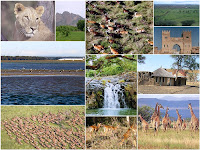Khartoum
 A historian of urbanism once described cities as cultural complexes that seem to have sprung up on the banks of a few great rivers. The nucleus of such settlements, he added, must have appeared long before the city had come to full maturity. Khartoum seems to conform to this principle, for at a much earlier date before its development into a large urban conglomerate in modern times, a Mesolithic (i.e. Middle Stone Age) flourished on the left bank of the Blue Nile. From the same location, Meroitic pottery dating between the first century BC and the second century AD was recovered.
A historian of urbanism once described cities as cultural complexes that seem to have sprung up on the banks of a few great rivers. The nucleus of such settlements, he added, must have appeared long before the city had come to full maturity. Khartoum seems to conform to this principle, for at a much earlier date before its development into a large urban conglomerate in modern times, a Mesolithic (i.e. Middle Stone Age) flourished on the left bank of the Blue Nile. From the same location, Meroitic pottery dating between the first century BC and the second century AD was recovered.The confluence of the Blue and White Niles, which is the main element of the topography of the City, must have dictated the choice of Khartoum as the seat of government during the early years of the Turco-Egyptian regime (1821-1885). This period witnessed a gradual expansion of the town in the modern times. Accounts of European travelers who visited the Sudan in the mid-19th century indicate that the town had become a place of considerable size and importance. Bayard Taylor who visited Khartoum in the early 1850s wrote: “Behind the town, the White Nile curves to the east, and during inundation its waters extend even to the suburbs, almost insulating the place… that the people were obliged to erect dykes to keep the water out of the streets”.
These earth dykes were primarily built by Khurshid Pasha, Turkish Hikimdar (Governor) of Sudan (1826-1838). The residential quarter adjoining this embankment along the Mogran area was known as Farieq el Taras (Dykes Quarter). The town was largely demolished during the Mahdist State (1885-1898) which chose Omdurman, on the left bank of the Nile, as an alternative capital.
The succeeding history of Khartoum commences with the Condominium regime (1899-1956), when planning along modern lines was begun. The general out-lay of the plan was drawn up by Lord Kitchener in 1899. In November 1901, the Municipality of Khartoum was established, among the tasks of which was the supervision and execution of the town plan. Alsunut
More on Khartoum: The Guardian, Wikipedia, Virtual Tourist, Sudan Tribune, Looklex, BBC, IHT, CNN, New York Times, Time, Alsunut, pbase, archeolink, citycomparator, witpress, YouTube
More Images: Alsunut


